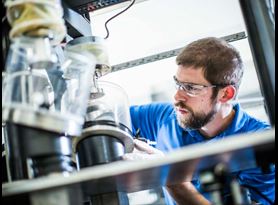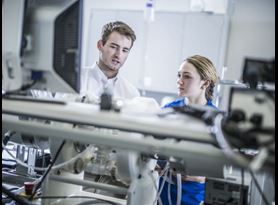Physical and Chemical Characterization of Medical Devices

By Engaged Expert
Maciej JakuckiMaciej Jakucki has performed and managed a wide variety of medical testing projects and programs to meet FDA and CE requirements.
When designing medical devices and instruments, physical and chemical characterization of materials is a critical step in the process.
At Element, we partner with customers to support comprehensive testing plans to characterize and qualify titanium, cobalt chrome, and stainless steel alloys, as well as non-metallic materials that will be used in implants and medical instruments. Our medical device testing experts work with material providers, contract manufacturers, and OEMs to ensure material quality throughout the manufacturing process.
Titanium, cobalt chrome, and stainless steel alloys are the most common materials used in the medical field due to their fatigue properties, corrosion resistance, and biocompatibility. However, these materials are exposed to multiple post-processing steps that can impact quality. PEEK, nitinol, ceramics, and other non-metallic materials are also being used in orthopedic, dental and cardiovascular implants and maintaining mechanical properties through the production process is key.
Characterization of metals
Titanium is the most common metal used in medical devices and implants due to its light weight, fatigue resistance, and corrosion resistance. The most common titanium alloys used in the medical field are alloyed with aluminum and vanadium: Ti 6Al-4V and Ti 6Al-4V ELI (extra-low interstitials). Commercially pure (CP) titanium is also found in implants, although it is typically used more in dentistry. Titanium is often the preferred material for medical devices due to its ability to integrate with bone and tissue.
Cobalt chrome alloys (CoCr or CoCrMo) are also biocompatible and are used for orthopedic and cardiovascular implants. The material’s corrosion resistance is increased by a passive protective film that forms along the surface. The high-polish capabilities of cobalt chrome make it useful for higher wear-resistance needed for joint implants. However, cobalt or chrome materials may generate ions when in contact against other dissimilar materials, causing potential risk to patients.
Stainless steel alloys such as 316 and Custom 465 provide excellent fracture toughness and fatigue resistance needed for screws, pins, plates, rods, and surgical instruments. The material allows manufacturers to produce smaller-diameter instruments and tools needed for surgeries that will not deform or break under the required torque and bending loads. Stainless steels are often used for more temporary or short-term implants, as well as surgical tools and instruments, due to their corrosion resistance and increased strength.
Metal materials are manufactured in a variety of ways, including forging, casting, subtractive machining, and additive manufacturing. Each of these manufacturing methods has unique considerations when it comes to the physical and chemical characterization of medical devices.
Characterization of additively manufactured materials
Innovations in additive manufacturing technologies have opened the door to customizable and patient-specific implants. Along with these innovations comes the need to ensure the materials retain their mechanical and material properties throughout the manufacturing process, resulting in evaluations for:
- Build plate positioning (location in the X, Y, and Z)
- Post-processing (heat treat, etc.)
- Powder characteristics
- Process differences, such as EBM, DMLS, etc.
The way parts are positioned in the build plate may also affect the microstructure and mechanical properties. Our medical device experts partner with our customers to investigate these variances. For additive manufactured parts and materials, we work with material providers to evaluate titanium and cobalt-chrome powders before printing. We also work with manufacturers to qualify material for as-built samples and validate post-processing.
Our physical and chemical characterization methods for medical devices
We provide a variety of physical and chemical characterization methods for metal alloys and non-metal materials, including:
- Tensile and hardness
- Material fatigue testing
- Static and fatigue product testing
- Chemical analysis
- Grain size evaluation
- Microstructure analysis (phase analysis, etc.)
- Surface evaluations (alpha case, anodization)
- Corrosion testing
Tensile testing for physical characterization
Tensile testing per ASTM E8 is routinely performed to evaluate cast, forged, and additively manufactured medical devices such as hip stems and knee femurs, and to verify mechanical properties of post-processed samples and materials. Tensile properties of titanium and cobalt chrome samples provide insight into how implants and materials will perform in service and are related to other mechanical properties such as fatigue and fracture toughness.
Chemical analysis and characterization
Chemical characterization of medical devices and materials confirms the composition of materials used, which is crucial for understanding the biocompatibility and mechanical properties. For example, the lower oxygen content of Titanium 6Al-4V ELI (0.13%wt max O) leads to higher ductility and fatigue strength than that of Titanium 6Al-4V (0.20wt% max O), which yields higher strength. ASTM F3001 and ASTM F2924 are test standards used for the chemical analysis of Ti 6Al-4V ELI and Ti 6AL-4V, respectively.
Metallurgical and failure analysis
Metallurgical analysis investigates the grain size, phase/microstructure, and surface, which are important when verifying material properties for medical devices. Grain size and microstructure are directly tied to chemical and mechanical properties. For example, finer grains lead to higher strength and toughness. The ASTM F3001 and ASTM F2924 standards call out specific phase requirements in the microstructure. Titanium microstructure can be very susceptible to alpha case hardening along the surface of a device. The presence of brittle alpha case can lead to decreased fatigue properties and premature failures.
Failure analysis using microscopy, SEM, and other methods is a critical component of characterization. Understanding whether components failed due to material defects, installation, artifact, or under normal use help OEMs make design changes and correct issues in the field. For example, laser markings in high-stress areas on spinal rods reduce strength significantly and considerations on the location of these markings can easily be missed. Whether confirming in physical product testing or evaluating in explants, failure information provides critical insights into how to make improvements.
Element as a trusted medical device testing partner
As a comprehensive medical device testing partner, you’ll enjoy the benefit of a single-source supplier for all of your testing needs, from feasibility and R&D to product development and production quality control.
For more information about how we can assist with the physical and chemical characterization of your medical devices, contact us today.
Find related Resources
Related Services

Medical Device Testing
As a comprehensive testing partner, you’ll enjoy the benefit of a single supplier source for all of your testing needs, from mechanical testing and environmental simulation to EMC and wireless device testing.

Medical Device Testing Tips
Preparing for a medical device testing program can be a challenge for many manufacturers, especially if it is a new or novel product or if time is limited. Our medical device experts share their testing tips and best practices.

Test Protocol for Medical Devices
A protocol and plan will mitigate your risk, prevent confusion, set clear expectations, and preserve the necessary information for future reference and use.

Resources
Discover blog posts, articles, white papers, webinars, and advice from our world-leading testing, inspection, and certification experts.

